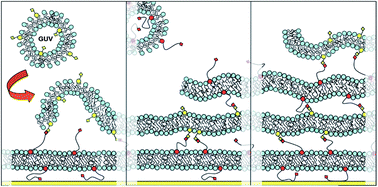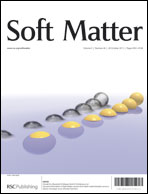Iterative layer-by-layer assembly of polymer-tethered multi-bilayers using maleimide–thiol coupling chemistry
Abstract
The current study reports on the layer-by-layer assembly of a polymer-tethered lipid multi-bilayer stack using the iterative addition and roll out of giant unilamellar vesicles (GUVs) containing constituents with thiol and maleimide functional groups, respectively. Confocal microscopy and photobleaching experiments confirm stack integrity and stability over time, as well as the lateral fluidity of individual bilayers within the stacks. Complementary wide-field single molecule fluorescence microscopy and atomic force microscopy experiments show that increasing bilayer-substrate distances are associated with changes in lipid lateral mobility and bilayer morphology. Importantly, the described iterative approach can be employed to assemble multi-bilayer stacks with more than two bilayers, thus further reducing the influence of the underlying solid substrate on membrane behavior. Furthermore, the presence of lipopolymers within the multi-bilayer stacks results in fascinating membrane dynamics and organization properties, with interesting parallels to those found in plasma membranes. In that sense, the described multi-bilayer architecture represents an attractive model membrane platform for a variety of different biophysical studies.


 Please wait while we load your content...
Please wait while we load your content...